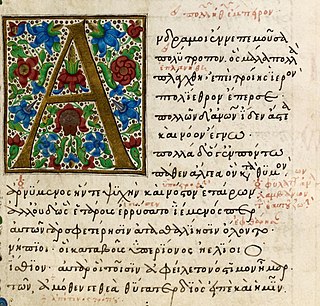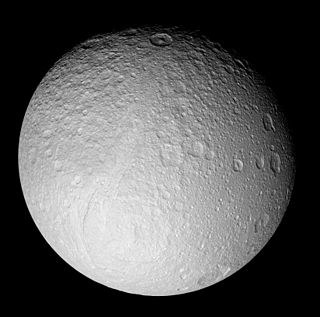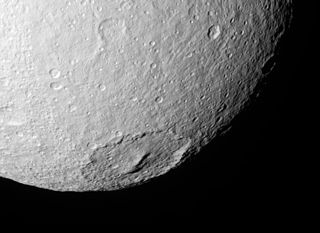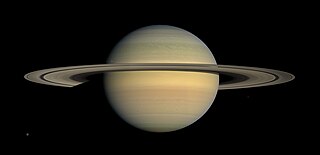
The Odyssey is one of two major ancient Greek epic poems attributed to Homer. It is, in part, a sequel to the Iliad, the other Homeric epic. The Odyssey is fundamental to the modern Western canon; it is the second-oldest extant work of Western literature, while the Iliad is the oldest. Scholars believe the Odyssey was composed near the end of the 8th century BC, somewhere in Ionia, the Greek coastal region of Anatolia.

Telesto is a moon of Saturn. It was discovered by Smith, Reitsema, Larson and Fountain in 1980 from ground-based observations, and was provisionally designated S/1980 S 13. In the following months, several other apparitions were observed: S/1980 S 24, S/1980 S 33, and S/1981 S 1.

Rhea is the second-largest moon of Saturn and the ninth-largest moon in the Solar System. It is the second smallest body in the Solar System for which precise measurements have confirmed a shape consistent with hydrostatic equilibrium, after dwarf planet Ceres. It was discovered in 1672 by Giovanni Domenico Cassini.

In Greek mythology, Eurycleia, or Euryclea, is the daughter of Ops and granddaughter of Peisenor, as well as the wet-nurse of Odysseus.

Calypso is a moon of Saturn. It was discovered in 1980, from ground-based observations, by Dan Pascu, P. Kenneth Seidelmann, William A. Baum, and Douglas G. Currie, and was provisionally designated S/1980 S 25. Several other apparitions of it were recorded in the following months: S/1980 S 29, S/1980 S 30, S/1980 S 32, and S/1981 S 2. In 1983 it was officially named after Calypso of Greek mythology. It is also designated as Saturn XIV or Tethys C.

The moons of Saturn are numerous and diverse, ranging from tiny moonlets less than 1 kilometer across to the enormous Titan, which is larger than the planet Mercury. Saturn has 62 moons with confirmed orbits, 53 of which have names and only 13 of which have diameters larger than 50 kilometers, as well as dense rings with complex orbital motions of their own. Seven Saturnian moons are large enough to be ellipsoidal in shape, yet only two of those, Titan and Rhea, are currently in hydrostatic equilibrium. Particularly notable among Saturn's moons are Titan, the second-largest moon in the Solar System, with a nitrogen-rich Earth-like atmosphere and a landscape featuring dry river networks and hydrocarbon lakes found nowhere else in the solar system; and Enceladus since its chemical composition is similar to that of comets. In particular, Enceladus emits jets of gas and dust, which could indicate the presence of liquid water under its south pole region, and may have a global ocean below its surface.
This is a directory of lists of geological features on planets excepting Earth, moons and asteroids ordered by increasing distance from the Sun.

Odysseus is the largest crater on Saturn's moon Tethys. It is 445 km across, more than 2/5 of the moon's diameter, and is one of the largest craters in the Solar System. It is situated in the western part of the leading hemisphere of the moon—the latitude and longitude of its center are 32.8°N and 128.9°W, respectively. It is named after the Greek hero Odysseus from Homer's the Iliad and the Odyssey.

Herschel is a huge crater in the leading hemisphere of the Saturnian moon Mimas, on the equator at 100° longitude. It is named after the eighteenth century astronomer William Herschel, who discovered Mimas in 1789. Herschel is the second-largest crater relative to its parent body of any equilibrium planetary moon in the Solar System after Tethys's crater Odysseus. It is so large that astronomers have expressed surprise that Mimas was not shattered by the impact that caused it. It measures 139 kilometres across, almost one third the diameter of Mimas. Its walls are approximately 5 km (3 mi) high, parts of its floor are 10–12 km (6–7 mi) deep, and its central peak rises 6–8 km above the crater floor. If there were a crater of an equivalent scale on Earth it would be over 4,000 km (2,500 mi) in diameter – wider than Canada – with walls over 200 km (120 mi) high. The impact that formed Herschel must have nearly disrupted Mimas entirely. Chasmata that may be stress fractures due to shock waves from the impact traveling through it and focusing there can be seen on the opposite side of Mimas. The impact is also suspected of having something to do with the current 'Pac-Man'–shaped temperature pattern on Mimas. Herschel has an estimated age of around 4.1 billion years.

Ithaca Chasma is a valley (graben) on Saturn's moon Tethys, named after the island of Ithaca, in Greece. It is up to 100 km wide, 3 to 5 km deep and 2,000 km long, running approximately three-quarters of the way around Tethys' circumference, making it one of the longer valleys in the Solar System. Ithaca Chasma is approximately concentric with Odysseus crater.
Penelope is the faithful wife of Odysseus in Homer's epic poem Odyssey.

Several of Saturn's natural satellites have figured prominently in works of science fiction.
Odysseus is a character in Greek mythology.

Melanthius is the third largest impact crater on Tethys, one of Saturn's moons. Melanthius is 245 kilometers (152 mi) wide, and is located in the southern quadrant of Melanthius, named after the crater. Melanthius is noted for its prominent cluster of central peaks, which were formed in the original impact. The crater is centered at 58.5°S, 192.61°W.

Mons is a mountain on a celestial body. The term is used in planetary nomenclature: it is a part of the international names of such features. It is capitalized and usually stands after the proper given name, but stands before it in the case of lunar mountains.


















